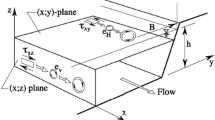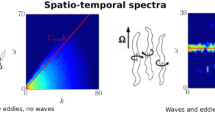Abstract
The effect of local forcing on the organization of a turbulent separated and reattaching flow was assessed by measuring wall pressure fluctuations. Multi-arrayed microphones were installed on the surface to measure the simultaneous spatial and temporal wall pressure fluctuations. Local forcing at the separation edge was applied to the separated flow over a backward-facing step through a thin slit. The organization of the separated and reattaching flow was found to be greatest at the effective forcing frequency. The flow structure was diagnosed by analyzing several characteristics of the wall pressure fluctuations: the wall pressure fluctuation coefficients, wall pressure spectrum, wavenumber-frequency spectrum, coherence, cross-correlation, and multi-resolution autocorrelations of pressure fluctuations using the maximum overlap discrete wavelet transform and continuous wavelet transform. Features indicative of the amalgamation of vortices under the local forcing were observed; this amalgamation process accounted for the observed reduction of the reattachment length. Examination of the wall pressure fluctuations revealed that introduction of local forcing enhanced flapping motion as well as the streamwise and spanwise dispersions of vortical structures.













Similar content being viewed by others
Abbreviations
- AR:
-
Aspect ratio
- MODWT:
-
Maximum overlap discrete wavelet transform
- CWT:
-
Continuous wavelet transform
- \(C_{p\prime } \) :
-
Wall pressure fluctuation coefficient, p′/0.5ρU 2∞
- H :
-
Step height of backward-facing step (mm)
- Re H :
-
Reynolds number (U∞H/ν)
- St :
-
The reduced frequency (fH/U∞)
- St f :
-
Normalized forcing frequency by unsteady wake (f p H/U∞)
- U ∞ :
-
Free-stream velocity (m/s)
- f :
-
Frequency (Hz)
- k x :
-
Streamwise wavenumber (1/m)
- k z :
-
Spanwise wavenumber (1/m)
- p′:
-
Instantaneous wall pressure (Pa)
- p′rms:
-
Root-mean-square of wall pressure (Pa)
- p ′ f :
-
Reconstructed multi-resolution pressure at central frequency f (Pa)
- q :
-
Dynamic pressure, 0.5ρ U 2∞ (Pa)
- u c :
-
Convection velocity (m/s)
- v rms :
-
Root-mean-square of total velocity (m/s)
- x R :
-
Time-mean reattachment length (mm)
- x R0 :
-
Time-mean reattachment length at St f =0 (mm)
- x 0 :
-
Streamwise position of reference point (mm)
- z 0 :
-
Spanwise position of reference point (mm) (z0=0)
- A 0 :
-
Forcing amplitude (Chun and Sung 1996)
- a :
-
Timescale dilation parameter (s)
- b :
-
Time transition parameter (s)
- w (b, a):
-
Continuous wavelet transform coefficient (pa)
- wc (a, τ):
-
Auto-correlation of continuous wavelet transform coefficients
- ξ :
-
Streamwise separation interval from x0 (m)
- ζ :
-
Spanwise separation interval from z0 (m)
- γ p :
-
Forward-flow time fraction
- δ :
-
Boundary layer thickness (mm)
- δ * :
-
Displacement thickness (mm)
- θ :
-
Momentum thickness (mm)
- ρpp (τ; x0):
-
Auto-correlation of pressure at x0
- ρpp (x0, τ, f):
-
Multi-resolution auto-correlation of pressure at x0 and f
- τ :
-
Time delay (s)
- ω :
-
Frequency (rad/s)
- Φp (f; x0):
-
Autospectrum of pressure measured at x0 (Pa2 s)
- Φpp (ζ, ω; x0):
-
Spanwise cross spectrum of pressure at x0 (Pa2 s)
- Φpp (k x , ω; x0):
-
Streamwise wavenumber-frequency spectrum of pressure at x0 (Pa2 s)
- Φpp (k z , ω; x0):
-
Spanwise wavenumber-frequency spectrum of pressure at x0 (Pa2 s)
References
Brederode V, Bradshaw P (1978) Influence of the side walls on the turbulent center-plane boundary-layer in a square duct. J Fluid Eng 100:91–96
Chun KB, Sung HJ (1996) Control of turbulent separated flow over a backward-facing step by local forcing. Exp Fluids 21:417–426
Chun KB, Sung HJ (1998) Visualization of locally-forced separated flow over a backward-facing step. Exp Fluids 25:133–142
Chun S, Liu YZ, Sung HJ (2003) Wall pressure fluctuations of a turbulent separated and reattaching flow affected by an unsteady wake. Exp Fluids 37:531–546
Eaton JK, Johnston JP (1980) A review of research on subsonic turbulent flow reattachment. AIAA J 19:1093–1100
Farabee TM, Casarella MJ (1986) Measurements of fluctuating wall pressure for separated/reattached boundary layer flows. J Vib Acoust Stress 108:301–307
Hudy LM, Naguib AM, Humphreys WM (2003) Wall pressure-array measurements beneath a separating/reattaching flow region. Phys Fluids 15:706–717
Kim J, Choi JI, Sung HJ (2002) Relationship between wall pressure fluctuations and streamwise vortices in a turbulent boundary layer. Phys Fluids 14:898–901
Kiya M, Sasaki K (1983) Structure of a turbulent separation bubble. J Fluid Mech 137:83–113
Kiya M, Sasaki K (1985) Structure of large-scale vortices and unsteady reverse flow in the reattaching zone of a turbulent separation bubble. J Fluid Mech 154:463–491
Kiya M, Shimizu M, Mochizuki O (1997) Sinusoidal forcing of a turbulent separation bubble. J Fluid Mech 342:119–139
Lee I, Sung HJ (2001) Characteristics of wall pressure fluctuations in separated flows over a backward-facing step. Part 2: unsteady wavelet analysis. Exp Fluids 30:273–282
Lee I, Sung HJ (2002) Multiple-arrayed pressure measurement for investigation of the unsteady flow structure of a reattaching shear layer. J Fluid Mech 463:377–402
Mabey DG (1972) Analysis and correlation of data on pressure fluctuations in separated flows. J Aircraft 9:642–645
Miau JJ, Lee KC, Chen MH, Chou KC (1991) Control of separated flow by a two-dimensional oscillatory plate. AIAA J 29:1140–1148
Percival DB, Walden AT (2000) Wavelet methods for time series analysis. Cambridge University Press, Cambridge
Sigurdson LW (1995) The structure and control of a turbulent reattaching flow. J Fluid Mech 298:139–165
Yoshioka S, Obi S, Masuda S (2001) Turbulence statistics of periodically perturbed separated flow over a backward-facing step. Int J Heat Fluid Fl 22:393–401
Author information
Authors and Affiliations
Corresponding author
Rights and permissions
About this article
Cite this article
Liu, Y.Z., Kang, W. & Sung, H.J. Assessment of the organization of a turbulent separated and reattaching flow by measuring wall pressure fluctuations. Exp Fluids 38, 485–493 (2005). https://doi.org/10.1007/s00348-005-0929-0
Received:
Revised:
Accepted:
Published:
Issue Date:
DOI: https://doi.org/10.1007/s00348-005-0929-0




